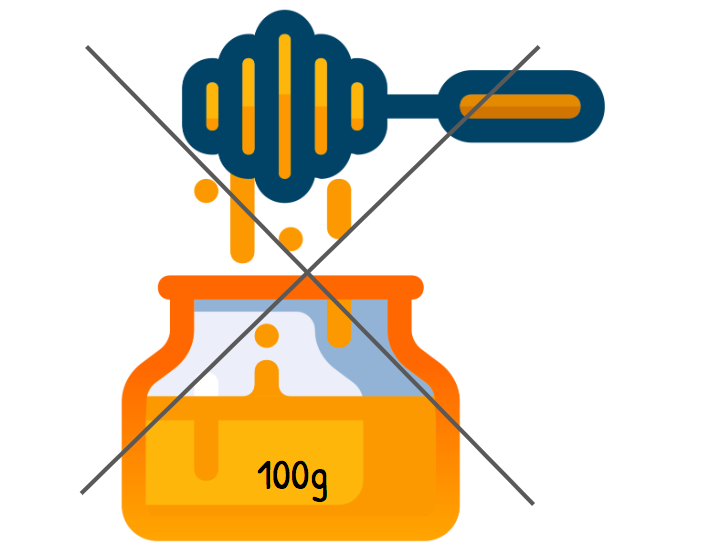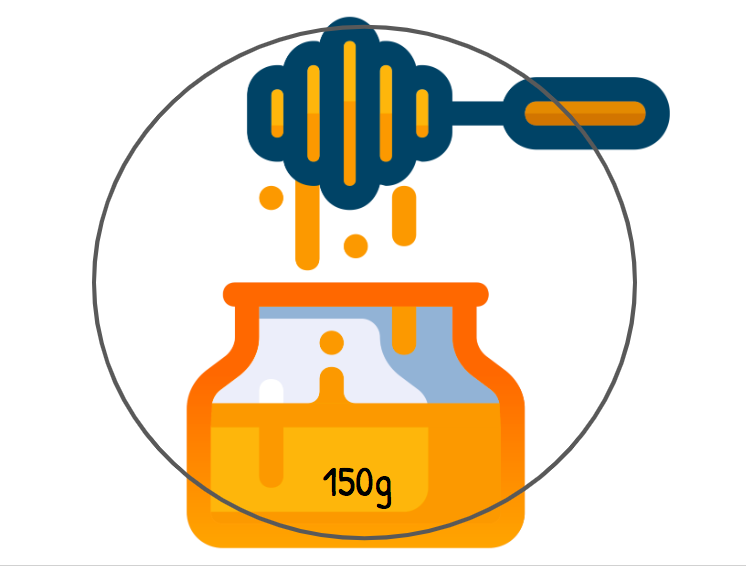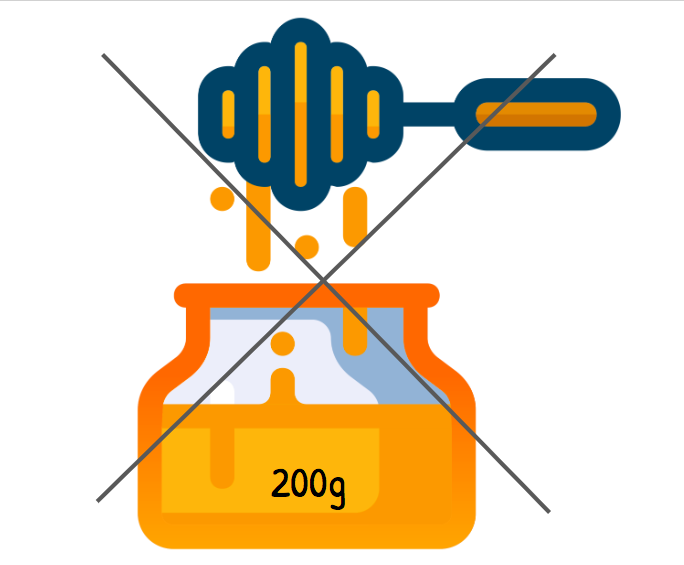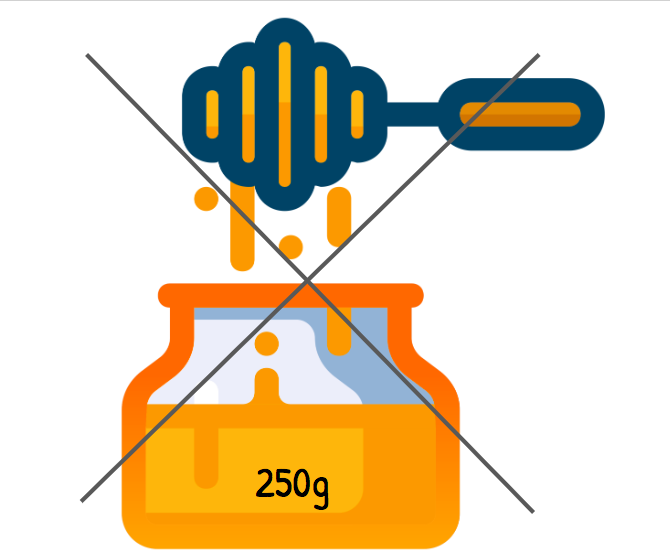32 of 100: Honey Takeaway
A full jar of honey weighs 750 grams, and the same jar two-thirds full weighs 550 grams. What is the weight of the empty jar in grams?
One-third of the honey has been taken away in the second jar, you just need to take out the remaining two-thirds!
This section requires Javascript.
You are seeing this because something didn't load right. We suggest you, (a) try
refreshing the page, (b) enabling javascript if it is disabled on your browser and,
finally, (c)
loading the
non-javascript version of this page
. We're sorry about the hassle.
21 solutions
Wondering why people are upvoting a solution that provides no explanation, just three equations.
Let, h be the weight of a full jar of honey (the weight of the jar is excluded here) and j be the weight of the jar alone. Now, according to the first condition h + j = 7 5 0 ⟹ 2 h + 2 j = 1 5 0 0 And, according to the second condition 3 2 h + j = 5 5 0 ⟹ 2 h + 3 j = 1 6 5 0 Subtracting the first equation from the second, we get j = 1 5 0
Why use j when y is so beautiful or why use x when h is so symbolic? (good solution)
Log in to reply
My bad! Maybe h would be better instead of x . Changed it now.
Log in to reply
Good job now it really is a good solution, i first fought this is a hard system so i used pen and paper, i didn't thought you would change it so fast good job.
Let, Jar= J, Honey= H
J + H = 750
J + 2/3 H = 550
Solving the equation we get,
J = 150
Intuitively, when we remove one-third of the honey, or one "part," we get a jar weighing 200 grams less. We still have two "parts" remaining so do what we did (subtract 200 grams) twice to get 5 5 0 − 2 0 0 − 2 0 0 = 1 5 0 .
While using variables is very important in mathematical problem solving, for the purposes of this problem, an intuitive solution is easier to visualize and makes more sense.
Let the weights of full jar of honey alone and the empty jar be h and j respectively. Then we have:
{ h + j = 7 5 0 3 2 h + j = 5 5 0 . . . ( 1 ) . . . ( 2 )
( 1 ) − ( 2 ) : 3 1 h = 2 0 0 ⟹ h = 6 0 0 grams. From ( 1 ) : j = 7 5 0 − h = 7 5 0 − 6 0 0 = 1 5 0 grams.
Alternative solution
Two times the 750-g jar is equal to two jars and two jar-fuls of honey.
Three times the 550-g jar is equal to three jars and two jar-fuls of honey.
The difference is one jar, which is therefore 3 × 5 5 0 − 2 × 7 5 0 = ( 3 × 1 1 − 2 × 1 5 ) × 5 0 = 3 × 5 0 = 1 5 0 g .
2/3 of a jar equals 550 grams, but the full jar weighs 750 grams. That means that 1/3 equals 200 grams. 200x3=600 750-600=150 grams ANSWER: 150 grams
suppose, jar=J and honey=H
so, J+H=750...........................(1)
and,J+2/3H=550...................(2)
so, 1/3H=200....................[subtracting equation 2 from 1]
or, H=200 x 3=600
or,J+H=750
or,J=750-600=150
so, the jar is 150 gm
Let's start by looking at the choices.
100g... If the jar was 100g, the full jar would have 650g of honey and the jar with two-thirds would have 450. 450 is not two thirds of 650, so the jar can't be 100g.

150g... The two-thirds jar would be 600g and the full jar would be 400g. 400 is two-thirds of 600 so the jar must be 150g.

200g... The full jar would be 550g and the two-thirds jar would be 350g. 350 isn't two-thirds of 550 so that can't be possible.

250g... The full jar would be 500g and the two-thirds jar would be 300g. Since 300 isn't two-thirds of 500, that can't be possible either.

So, the weight of the empty jar is 150g!
Image Source: https://openclipart.org/detail/292529/honey-jar
We can interpret the overall weight of the jar as the weight of the honey plus the weight of the jar. Between the first and second jar, 3 1 of the first jar is removed to form the second jar, totaling a difference of 2 0 0 . Therefore, the weight of the honey is 2 0 0 ⋅ 3 = 6 0 0 . Subtracting that from the full jar, we get 7 5 0 − 6 0 0 = 1 5 0
This I found real easy. If the original weight of the honey was 750 grams and 1/3 was taken away to get 550 grams. That meant that the 1/3 taken away weighed 200 grams because 750-550=200. So, if 1/3 was 200 grams then the other thirds are also 200 grams. So, in total the 3 thirds are 600 grams because 3x200=600. So, if the whole jar was full with 750 grams, and the honey inside was 600 grams, the last math problem is 750-600=150. So, your answer must be 150 grams.
Let the Honey be H and the Jar be J
750 - 550 = 200
200 = 3 1 H
H = 200 x 3
H = 600
750 - H = J
750 - 600 = J
J = 750 - 600
J = 150
The Jar weighs 150 grams
x=honey
y=jar
x+y=750
2/3x+y=550
then
x+1.5y=825
you subtract x+y=750 from that
and you get
0.5y=75
y=150
- The weight of the jar and a jarful of honey is 7 5 0 g .
Jar + Honey = 7 5 0
- When you take away 3 1 of a jarful of honey, the weight becomes 5 5 0 g .
Jar + 3 2 Honey = 5 5 0
- The difference between the two weights should be the weight of the honey removed.
3 1 × Honey = 7 5 0 − 5 5 0 Honey = 2 0 0 × 3 ∴ Honey = 6 0 0
- If the weight of a jarful of honey is 6 0 0 g , the weight of the jar should be
Jar + 6 0 0 = 7 5 0 Jar = 7 5 0 − 6 0 0 ∴ Jar = 1 5 0
Let j = weight of the jar
The honey in the first picture is 750 - j
The honey in the second picture is 550 - j
Since the honey in the second picture is 2/3 of the honey in the first picture, we can write this proportion:
7 5 0 − j 5 5 0 − j = 3 2
Cross multiplying gives you:
3(550 - j) = 2(750 - j)
1650 - 3j = 1500 - 2j
150 = j
Let h be 1/3rd of the weight of the honey, and j be the weigh of the jar alone. Then: 3h+j=750 and 2h+j=550 Solving for h and j, we get 1h=200 Then 3h=600 750-3h=150 as the weight of the jar. ☺☺☺☺
Suppose, Jar and honey are J and H respectively.
J + H = 7 5 0 . . . . . . . . . . . . . . . . . . . . . . . . . . . ( 1 )
J + 3 2 H = 5 5 0 . . . . . . . . . . . . . . . . . . . . ( 2 )
Subtracting the two equations ( 1 ) − ( 2 ) we get,
⇒ 3 1 H = 2 0 0
⇒ H = 2 0 0 × 3
⇒ H = 6 0 0
Now we have the value of H so need to substitute H = 6 0 0 in equation ( 1 ) .
J + H = 7 5 0
⇒ J = 7 5 0 − 6 0 0
Therefore J = 1 5 0
Whilst the solution can be found by creating a linear system of equations, this particular problem can be solved a much simpler manner.
The difference between the weight of the full jar of honey and the weight after removal of 3 1 the quantity of honey is the weight corresponding to the 3 1 the quantity of honey. The difference is 2 0 0 grams, hence the weight of the honey when the jar is completely filled is simply 3 × 2 0 0 = 6 0 0 grams. From the fact that the weight of the fully filled jar is 7 5 0 grams, the weight of the empty jar is 7 5 0 − 6 0 0 = 1 5 0 grams.
Simply, 750 - 550 = 200 gm. Therefore, 200 gm is the weight of the honey removed. And since the amount of honey removed is 1/3 of total honey in jar, the total weight of honey is 600 gm ( 200 * 3). Hence, 750 - 600 = 150 gm is the weight of the jar.
750 - 550 = 200
200 * 3 = 600
750 - 600 = 150